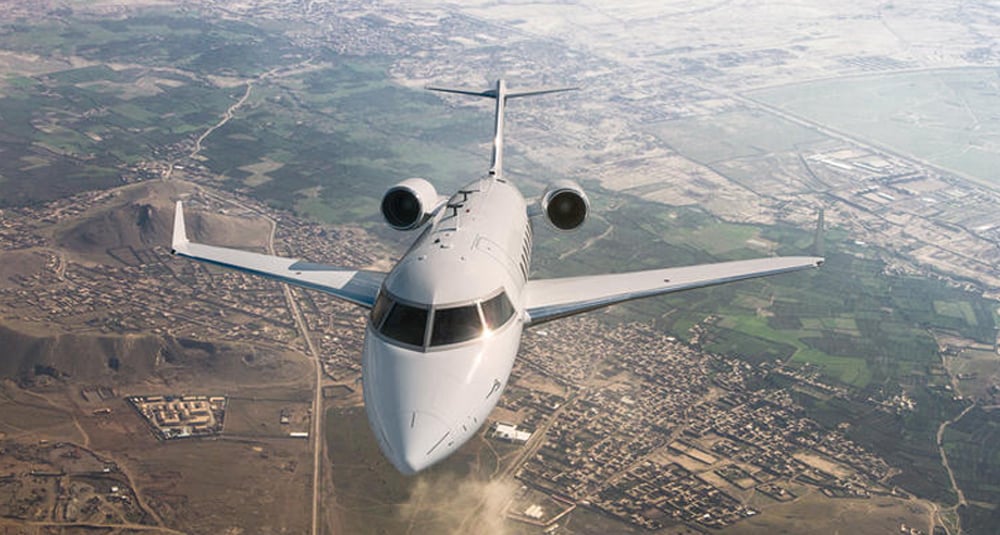Click Here to View This Page on Production Frontend
Click Here to Export Node Content
Click Here to View Printer-Friendly Version (Raw Backend)
Note: front-end display has links to styled print versions.
Content Node ID: 405223
L3Harris Technologies has competed the first flight of its Airborne Reconnaissance and Electronic Warfare System (ARES) platform. The aircraft—a heavily modified Bombardier Global 6500—undertook its maiden voyage from the company’s facility at Waco, Texas, where it has been rapidly outfitted with a surveillance mission system. The Pentagon gave the go-ahead for the program in November 2020.
“L3Harris is helping the U.S. Army rapidly expand its ISR capabilities with ARES,” said Luke Savoie, President, Aviation Services for L3Harris. “Our design, fabrication, and integration team turned a green airframe into an initial single sensor-capable platform with new sensing technology in six months.”
ARES has been produced as a technology demonstrator for the U.S. Army’s High Accuracy Detection and Exploitation System (HADES) program, which seeks to integrate capabilities from the service’s current intelligence, surveillance, reconnaissance (ISR) fleet, as well as being able to add additional payloads. HADES also addresses the need for greater stand-off ranges and platform survivability. The adoption of a business jet such as the Global 6500 as the carrier enables the mission to be conducted from altitudes above 40,000 feet, in turn significantly expanding the line-of-sight horizon. This enables the platform to operate further away from hostile territory and challenged borders, decreasing the aircraft’s vulnerability to air defenses. Moreover, the high speed and long range of the Global allow it to be deployed to the operational theater with much greater speed than the current King Air-based aircraft.
With an ability to patrol at mission altitude for as long as 14 hours, the Global 6500 can accommodate up to 14,000 pounds of mission equipment and has the size, weight, and power capability to accommodate the Army’s longest-ranged sensors, with the capacity to add further systems. The ARES could form a crucial element in the ability to deploy Long Range Precision Fires (LRPF) in response to threats. As such, it could be considered as a key sensor-to-shooter (S2S) enabler.
In the meantime, Leidos has also produced a technology demonstrator, known as the Leidos Special Mission Aircraft (LSMA). Development began in early 2019, with an Army contract being received in November that year, and the LSMA has been demonstrated in exercises in the U.S., Europe, and the Pacific theaters. LSMA uses a Bombardier Challenger 650 airframe. It is equipped with the Aerial Reconnaissance and Targeting Exploitation Multi-Mission Intelligence System (ARTEMIS), which features a plug-and-play architecture to allow rapid reconfiguration and upgrade of the mission suite. While the L3Harris ARES offers more available power and capacity for mission systems and better performance, Leidos claims that the smaller size of the Challenger airframe removes the need for the alteration of current aircraft-handling infrastructure.

HADES could ultimately produce an aircraft to replace the Army’s current intelligence, surveillance, and reconnaissance fleet, which is mostly based on Beechcraft King Air 200 and 350 aircraft. The older RC-12 Guardrail Common Sensor System (GCRS) King Air 200s are becoming obsolete from both an operational and systems standpoint, and are rapidly approaching the end of their viability in the face of battlefield developments.
The Enhanced Medium Altitude Reconnaissance and Surveillance System (EMARSS) King Air 350s are newer, but suffer from performance and payload constraints, as well as a limited capability to carry multiple sensors. While all 24 EMARSS platforms can carry high-definition video, they are otherwise tailored for a particular capability. The family comprises EMARSS-G (geospatial intelligence with wide-area surveillance and LIDAR), EMARSS-M (multi-int with signals intelligence), EMARSS-S (broad spectrum signals intelligence), and EMARSS-V (VADER radar, with vehicle and dismount moving target indication).
The Army has also issued a requirement for two EMARSS-E aircraft with electronic intelligence capability. This sub-variant is expected to fly during 2021. Data gathered from its operations will be used—along with that from the ARES and LSMA programs—to inform the final requirement for HADES.